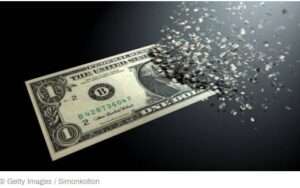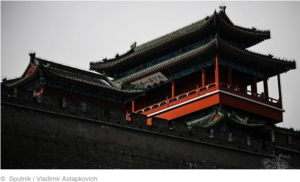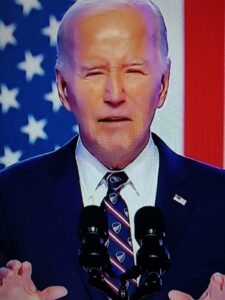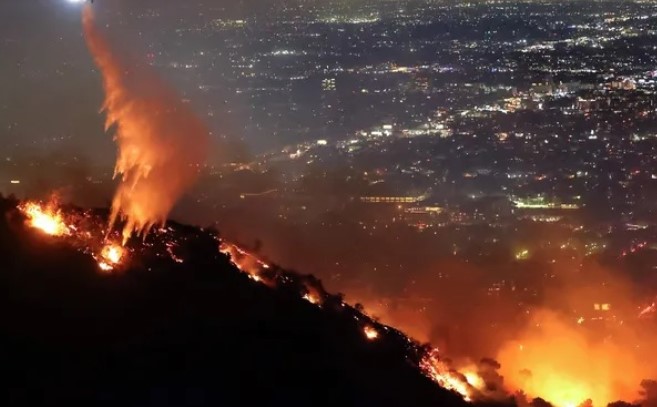
STRATEGIC ASSESSMENT. The “weaponization” of the US dollar through the seizure of frozen Russian assets could prompt a global shift away from the greenback, Bloomberg reported, citing a former International Monetary Fund (IMF) official. US President Joe Biden signed a bill this week allowing the administration to seize Russian state assets held in America.
Washington has long insisted on the confiscation of the funds to aid Ukraine in its war effort against Moscow. Meanwhile, G7 finance chiefs and EU officials continue to express concerns about the legal precedent of any asset seizure. The US and its allies have frozen around $300 billion in Russian central bank assets, around $5 billion of which is sitting in US banks as part of Ukraine-related sanctions.

As quoted by Bloomberg, former IMF official Eswar Prasad has warned that “America’s supercharged weaponization of its currency through the seizure of dollar reserves will certainly cause US rivals [to look at de-dollarization].”
The so-called REPO Act, which Biden signed on Wednesday along with a $61 billion military aid package for Kiev, authorized the US president to seize Russian state assets held in American banks and transfer them to a Ukraine reconstruction fund.
“It is necessary and urgent for our international coalition to unlock the value of immobilized Russian sovereign assets,” US Treasury Secretary Janet Yellen said in a statement on Wednesday.
The REPO provision has intensified debate over the potential consequences of foreign demand for US Treasuries and use of the dollar, Bloomberg noted. The outlet also said it is unlikely that the US will seize Russian assets without agreement from other G7 nations and the EU.
JPMorgan analyst Katherine Lei was quoted as saying that “China may accelerate the process of de-dollarization.” About 70% of Chinese international trade is still denominated in dollars, according to JPMorgan estimates.

Russian Deputy Foreign Minister Sergey Ryabkov warned that Moscow could downgrade diplomatic relations with Washington if the US expropriates frozen Russian funds.
Moscow’s response to the seizure of its assets could include economic and diplomatic countermeasures, Ryabkov said.
The latest macroeconomic data released by the US Department of Commerce indicates that the country’s economy could be moving towards stagflation, Business Insider has reported. The gloomy signs hint at tough challenges ahead, the outlet added.
American GDP increased at an annualized rate of only 1.6% in the first quarter of the current year, well behind projections of 2.5%. The slower than expected growth followed a 3.4% gain recorded in October-December 2023 and 4.9% in the previous quarter.
Weak growth and soaring consumer prices are distinct signs of stagflation, which is characterized by economic sluggishness and rising inflation over a prolonged period of time. The US was last hit with stagflation in the 1970s, when inflation surged into double digits as the economy tumbled. US policymakers responded by hiking the key interest rate to as much as 20%, cooling down prices but sending the economy into a deep recession.
In March, the US Federal Reserve skipped an interest rate hike, leaving it unchanged between the 5.25%–5.5% target range. The next meeting of the Fed’s Open Market Committee is scheduled on May 1.
At the same time, the personal consumption expenditures price index, used as a key inflation measure by the Fed, increased at a 3.4% annualized pace, marking the biggest gain in a year. Consumer spending in the US saw a 2.5% increase in January through March, down from a 3.3% gain in the fourth quarter of 2023, and below the projected 3%, the Bureau of Economic Analysis reported.
According to Business Insider, this puts serious limits on the Fed’s ability to take action, as the regulator has made clear it needs inflation to decline before any rate cuts can happen.
Economic aides to former US President Donald Trump are looking for options to stop countries from shifting away from the US dollar as it faces a growing challenge from emerging markets, including BRICS nations, Bloomberg reported.
The presumptive Republican nominee for the November presidential election and his team are discussing penalties against both allies and adversaries who seek to divert their trade from the greenback to other currencies. The options could include export controls, currency manipulation charges, and tariffs, the outlet said, citing people familiar with the matter.
The global trend toward using national currencies in trade instead of the dollar gained significant momentum after Russia was cut off from the Western financial system and had its foreign reserves frozen in 2022, as part of Ukraine-related sanctions.
A bill with provisions authorizing the US to confiscate frozen Russian assets, which Biden signed on Wednesday, could further spur de-dollarization, financial experts have warned. The so-called REPO Act, which was incorporated in the $61 billion military aid package for Kiev, authorized the US president to seize Russian state assets held in American banks.
As quoted by Bloomberg, Trump warned that with US President Joe Biden, “you’re going to lose the dollar as the standard. That’ll be like losing the biggest war we’ve ever lost.”
According to the news agency, Trump’s economic advisers and his campaign team have specifically considered curbing de-dollarization efforts by BRICS countries.
The group – which recently expanded and now comprises Brazil, Russia, India, China, South Africa, Ethiopia, Iran, Egypt – is boosting the use of national currencies in mutual trade. It has even signaled the possibility of introducing a new single currency in the coming years.
Trump has repeatedly said that he wants the dollar to remain the world’s reserve currency.
Up to half of transactions between Russia and China are facilitated by means of intermediaries to avoid exposure by Chinese lenders to the risk of secondary sanctions, Reuters reported on Friday, citing trade consultants and bankers, as well as importers and exporters.

In December, US President Joe Biden signed an executive order that takes additional steps against facilitating transactions with Russia. At the time, the US Treasury was calling on foreign banks to boost compliance with anti-Russia sanctions.
In March, newspaper Izvestia revealed that several Chinese banks, including the Industrial and Commercial Bank of China, stopped accepting payments in yuan from Russia for fear of secondary sanctions, with almost 80% of payments to China coming back.
According to informed sources speaking with Reuters on condition of anonymity, middlemen helping Moscow and Beijing to carry out cross-border payments are represented by legal entities in Hong Kong, Kyrgyzstan, Kazakhstan, the UAE and other nations that have opted not to back sanctions policies targeting Russia.
Some companies have reportedly switched to the services of payment agents, creating chains of temporary firms to make payment processes faster.
Two Russian consultants working with intermediaries told the news agency that nearly half of Russian entities working with Chinese firms are opting for their services, while major Russian businesses, most of which were targeted by Ukraine-related sanctions, established schemes with middlemen a year ago.
Shipment delays and prolonged transactions have reportedly forced businesses to turn to intermediaries, despite increased fees that may amount to several thousand dollars for each transaction, as well as a major risk of sanctions-related shipment seizures in third countries. According to one of the sources, a large batch of servers being transferred to Russia from China via Kazakhstan was confiscated after the shipment fell under the scope of US sanctions.
The use of intermediaries doesn’t provide companies with guarantees, as payments can still be refused by Chinese banks, while the less official nature of those settlements means that Russian firms may struggle to get their money back. Only a fifth of Russian firms reportedly have full access to their Chinese bank accounts, while 30% have limited access.
Some businesses, according to Reuters’ sources, have expressed hope that President Vladimir Putin’s visit to China next month will help resolve the issue, while others are less optimistic, one remarking that Russia is not a top priority for Chinese banks, despite booming trade between the nations.
A St. Petersburg court ordered the freezing of funds owned by US banking giant JPMorgan Chase in Russia on Wednesday. The ruling was made in favor of the country’s second-largest lender, VTB, which had filed a lawsuit seeking to recover $439.5 million blocked abroad under US-led sanctions.
VTB sued JPMorgan and its subsidiaries in the Arbitration Court of St. Petersburg and Leningrad Region on April 17, court filings showed on Monday. The order targeted funds in JPMorgan’s Russian accounts and “movable and immovable property,” including the bank’s stake in a Russian subsidiary.
The dispute centers on $439.5 million in funds that VTB held in a JPMorgan account in the US, which were blocked by Washington as part of Ukraine-related sanctions in 2022.
The court ordered the seizure of all funds in JPMorgan bank accounts in Russia, including correspondent accounts and those opened in the name of a subsidiary.
It also revealed that VTB had requested interim steps because the respondents were “taking measures to withdraw their assets” from Russia, while the Russian lender was seeking to recover money from the US bank.
In its own lawsuit against VTB last week in the Southern District of New York, JPMorgan sought to block the Russian bank’s efforts, noting that US law prohibited the bank from releasing the $439.5 million owned by VTB.
JPMorgan is concerned that VTB will try to seize its Russian assets, Reuters reported citing the US lender.
The Wall Street bank admitted to the outlet that VTB’s prospects were good, since Russian courts had granted at least six other local lenders relief against US and EU banks that were required to comply with sanctions laws.
The next hearing in the JPMorgan case is scheduled for July 17.
The “weaponization” of the US dollar through the seizure of frozen Russian assets could prompt a global shift away from the greenback, Bloomberg reported on Wednesday, citing a former International Monetary Fund (IMF) official.
US President Joe Biden signed a bill this week allowing the administration to seize Russian state assets held in America.

Washington has long insisted on the confiscation of the funds to aid Ukraine in its war effort against Moscow. Meanwhile, G7 finance chiefs and EU officials continue to express concerns about the legal precedent of any asset seizure. The US and its allies have frozen around $300 billion in Russian central bank assets, around $5 billion of which is sitting in US banks as part of Ukraine-related sanctions.
As quoted by Bloomberg, former IMF official Eswar Prasad has warned that “America’s supercharged weaponization of its currency through the seizure of dollar reserves will certainly cause US rivals [to look at de-dollarization].”
The so-called REPO Act, which Biden signed on Wednesday along with a $61 billion military aid package for Kiev, authorized the US president to seize Russian state assets held in American banks and transfer them to a Ukraine reconstruction fund.
Russia’s financial stability will not be affected if the US seizes its frozen assets, Bank of Russia Governor Elvira Nabiullina told journalists on Friday.
The US and its allies have blocked around $300 billion in Russian central bank assets as part of Ukraine-related sanctions, most of which are being held in the EU. On Wednesday, US President Joe Biden signed a bill allowing the White House to seize some $6 billion in Russian state assets that are sitting in US banks.
The Bank of Russia has been diversifying its forex reserves for several years, and is currently conducting operations with reserves that are not affected by sanctions, she added.
The White House has long insisted on confiscating the funds to aid Ukraine in its war effort against Russia. Meanwhile, EU lawmakers, as well as G7 finance chiefs, have raised deep concerns over the legal ramifications of any asset seizure. EU nations, which hold the lion’s share of frozen Russian funds, are concerned that expropriating them would trigger an outflow of investment and destabilize the euro.
Nabiullina previously warned that the seizure of profits from frozen Russian funds, as well as the confiscation of the funds themselves, would lower the attractiveness of the euro and the dollar as reserve currencies in international markets.
Moscow has repeatedly said the seizure of its assets would be “theft.” After the US House of Representatives approved the bill authorizing the confiscation of Russian money, Kremlin spokesman Dmitry Peskov warned that Moscow would immediately retaliate to the move.

Russian Deputy Foreign Minister Sergey Ryabkov has said Moscow could downgrade diplomatic relations with Washington if the assets are seized.
The International Monetary Fund (IMF) has upgraded its forecast for Russia’s economic growth in 2024, as surging military spending helps shield the sanctions-battered country from an economic downturn.
Russia’s economy is expected to grow 3.2% this year, up from the previous forecast of 2.6% issued in January, the IMF said in its World Economic Outlook report published on Tuesday.
The Kremlin has earmarked 10.8 trillion rubles ($115 billion) for defense spending in 2024, thus placing its economy more firmly on a war footing as the conflict in Ukraine drags on with seemingly no end in sight.
The splurge in spending has helped Russia defy predictions of a sharp downturn that some observers initially predicted when President Vladimir Putin launched the full-scale invasion of Ukraine in February 2022.
But the mobilization of hundreds of thousands of soldiers, an increase in domestic arms production and an exodus of men seeking to avoid being drafted into the military have created deep labor shortages in parts of the economy.
All of that has combined to create a spiral of rising wages and consumer prices.
Russia’s Central Bank kept interest rates unchanged last month, as Governor Elvira Nabiullina warned that the economy continued to show signs of overheating.
A country’s success, including on the battlefield, depends on how quickly technological challenges are resolved, Putin said. “And we are making it!” he told the gathering.
Russia’s economy has been positively dynamic, he reported. Gross Domestic Product (GDP) has demonstrated “good growth” in the first months of this year, following 3.6% growth in 2023, he said. In January 2024 GDP growth was 4.6% in annual terms and, in February, 7.7%. “Despite the unprecedented challenges we have faced in recent years, positive trends are strengthening in the domestic economy,” he told the audience.
The Russian economy has gained strong momentum, which could be seen from the state of the labor market. Unemployment remains at a historic low of less than 3%, and has also fallen among young people.
“The growth in employment … among other things is the result of the efforts of businesses, companies, and the entire business community,” Putin emphasized. The average monthly salary in real terms increased by 8.5% in January, and real incomes in 2023 rose by 5.4%. Touching on a projected shortage of personnel in Russia, the president said this cannot be covered by migrant workers, and called for other approaches to be taken.
The Russian president urged that relevant authorities ensure maximum transparency for the conduct and development of business in the country. Every opportunity exists, he said, including “solid state resources and the potential of domestic business,” to implement the planned initiatives.
“The government will continue to support businesses so that they launch promising projects, increase capital investment, and create new jobs,” the Russian leader told the union congress.
The president cited tax system reform as key among important steps to improve the investment climate in Russia. He noted that new tax conditions should be fixed for longer terms.
Putin recalled that law enforcement agencies have recently initiated proceedings to return some assets to state ownership.
In the next six years, we need to radically … increase the volume of industrial production. Moreover, new enterprises, including high-tech ones, in critically important areas should appear literally everywhere,” Putin reiterated.
Companies that implement individual projects could use special state-support measures, which would be gradually expanded, he said. In particular, additional resources will be directed to the development of industrial mortgages.
Russia’s strategic task is to increase the production of goods and services, primarily on its own technological base,” the president emphasized.





